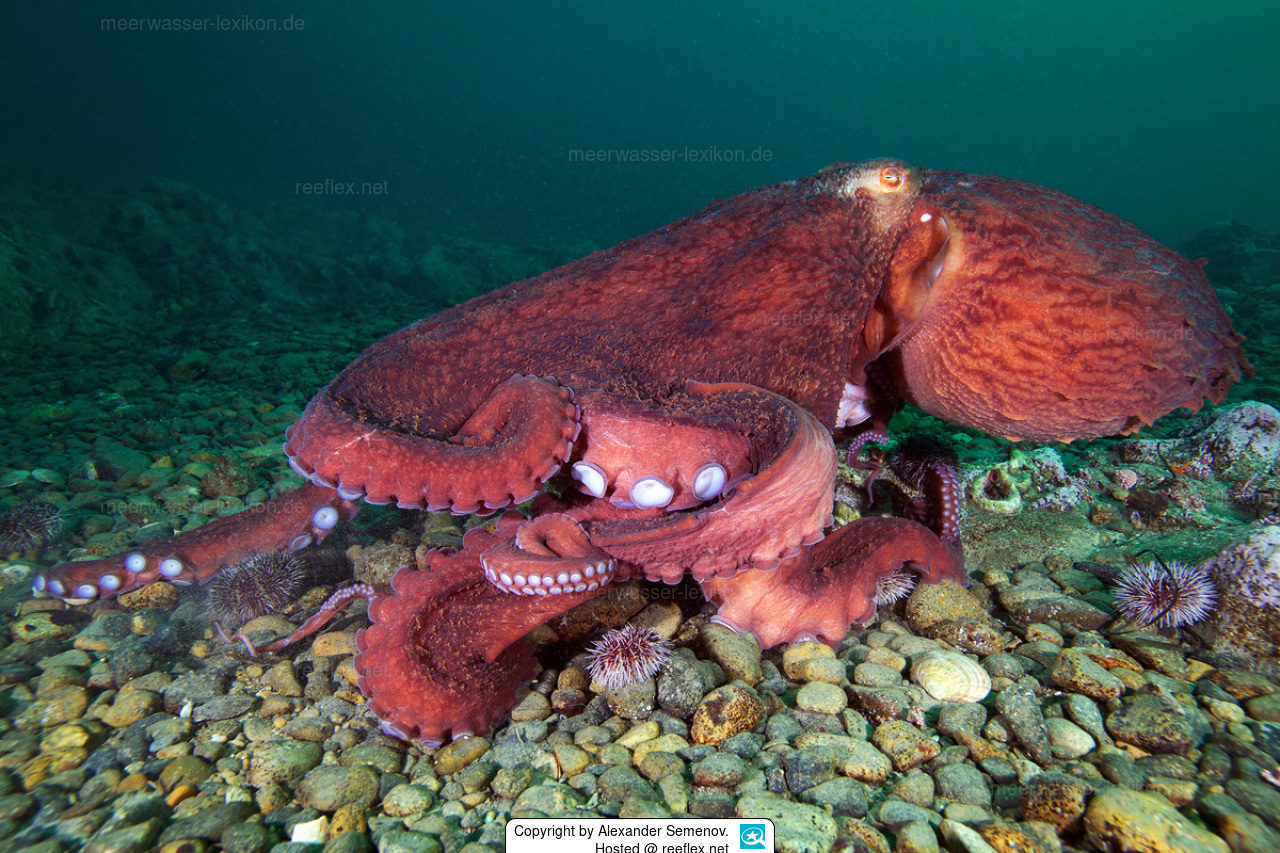Haltungsinformationen
Enteroctopus dofleini (Wülker, 1910)
Enteroctopus dofleini ist der Pazifische Riesenoktopus und die größte Oktopusart der Welt. Die Mantellänge beträgt mindestens 60 cm. Übliches Gewicht: 2.000 bis 10.000 g. Weibchen werden größer als Männchen. Die radiale Ausbreitung kann bis zu 9,8 m betragen. Nicht im tiefen, offenen Ozean zu finden.
Man findet ihn auf felsigen und weichen Böden in der Nähe von Spalten oder Höhlen von der niedrigen Gezeitenzone bis zu einer Tiefe von 180 Metern. Kann bis zu einer Tiefe von möglicherweise 1000 m vorkommen. Kommt auch auf Schlamm, Sand und Kies vor. Von der Küste bis zum Rand des Festlandsockels gefunden. Hauptsächlich benthisch. Generalistisches Raubtier. Verzehrt hauptsächlich Krebstiere und Weichtiere. Wird von großen Fischen und Meeressäugetieren gejagt.
Synonyme:
Enteroctopus dofleini apollyon (S. S. Berry, 1912) · unaccepted
Enteroctopus dofleini dofleini (Wülker, 1910) · unaccepted
Enteroctopus dofleini martini (Pickford, 1964) · unaccepted
Octopus apollyon (S. S. Berry, 1912) · unaccepted
Octopus dofleini (Wülker, 1910) · unaccepted
Octopus gilbertianus (S. S. Berry, 1912) · unaccepted
Octopus punctatus Gabb, 1862 · unaccepted
Paroctopus asper Akimushkin, 1963 · unaccepted
Paroctopus dofleini (Wülker, 1910) · unaccepted
Polypus apollyon S. S. Berry, 1912 · unaccepted
Polypus dofleini Wülker, 1910 · unaccepted (original combination)
Polypus gilbertianus S. S. Berry, 1912 · unaccepted
Unterarten (3)
Subspecies Enteroctopus dofleini apollyon (S. S. Berry, 1912) accepted as Enteroctopus dofleini (Wülker, 1910)
Subspecies Enteroctopus dofleini dofleini (Wülker, 1910) accepted as Enteroctopus dofleini (Wülker, 1910)
Subspecies Enteroctopus dofleini martini (Pickford, 1964) accepted as Enteroctopus dofleini (Wülker, 1910)
Enteroctopus dofleini ist der Pazifische Riesenoktopus und die größte Oktopusart der Welt. Die Mantellänge beträgt mindestens 60 cm. Übliches Gewicht: 2.000 bis 10.000 g. Weibchen werden größer als Männchen. Die radiale Ausbreitung kann bis zu 9,8 m betragen. Nicht im tiefen, offenen Ozean zu finden.
Man findet ihn auf felsigen und weichen Böden in der Nähe von Spalten oder Höhlen von der niedrigen Gezeitenzone bis zu einer Tiefe von 180 Metern. Kann bis zu einer Tiefe von möglicherweise 1000 m vorkommen. Kommt auch auf Schlamm, Sand und Kies vor. Von der Küste bis zum Rand des Festlandsockels gefunden. Hauptsächlich benthisch. Generalistisches Raubtier. Verzehrt hauptsächlich Krebstiere und Weichtiere. Wird von großen Fischen und Meeressäugetieren gejagt.
Synonyme:
Enteroctopus dofleini apollyon (S. S. Berry, 1912) · unaccepted
Enteroctopus dofleini dofleini (Wülker, 1910) · unaccepted
Enteroctopus dofleini martini (Pickford, 1964) · unaccepted
Octopus apollyon (S. S. Berry, 1912) · unaccepted
Octopus dofleini (Wülker, 1910) · unaccepted
Octopus gilbertianus (S. S. Berry, 1912) · unaccepted
Octopus punctatus Gabb, 1862 · unaccepted
Paroctopus asper Akimushkin, 1963 · unaccepted
Paroctopus dofleini (Wülker, 1910) · unaccepted
Polypus apollyon S. S. Berry, 1912 · unaccepted
Polypus dofleini Wülker, 1910 · unaccepted (original combination)
Polypus gilbertianus S. S. Berry, 1912 · unaccepted
Unterarten (3)
Subspecies Enteroctopus dofleini apollyon (S. S. Berry, 1912) accepted as Enteroctopus dofleini (Wülker, 1910)
Subspecies Enteroctopus dofleini dofleini (Wülker, 1910) accepted as Enteroctopus dofleini (Wülker, 1910)
Subspecies Enteroctopus dofleini martini (Pickford, 1964) accepted as Enteroctopus dofleini (Wülker, 1910)







 Alexander Semenov, Russland
Alexander Semenov, Russland







